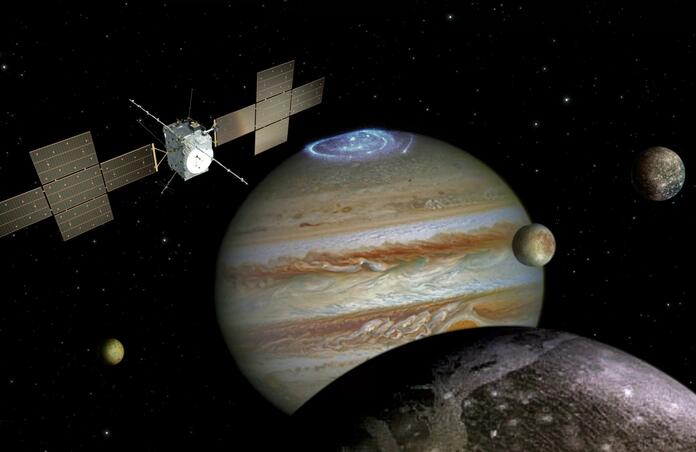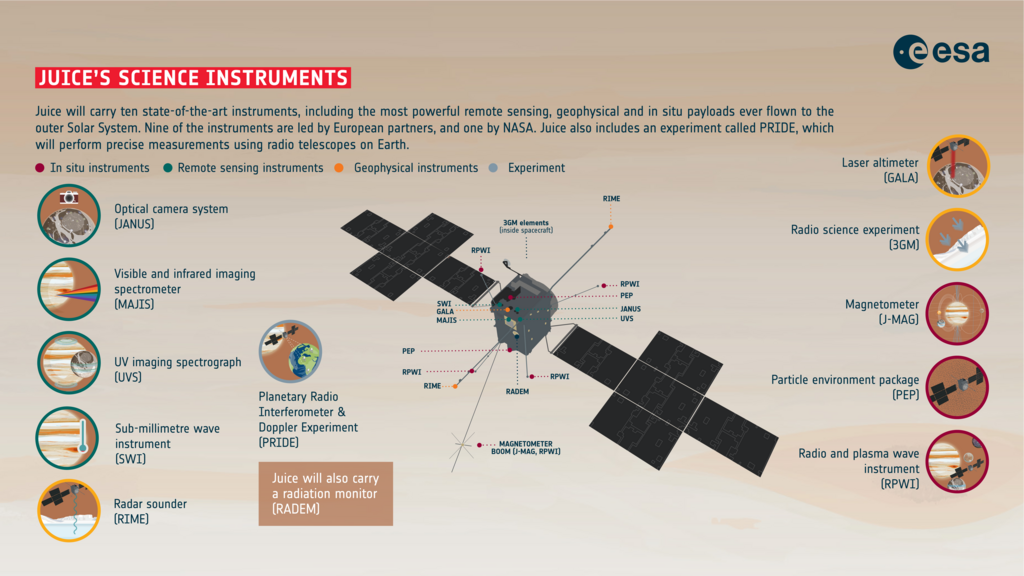ESA's Juice mission - a search for life on Jupiter's icy moons

ESA’s Jupiter Icy Moons Explorer, ‘Juice’ is the next mission planned to wander to the outer solar system, and is set for launch on Friday (14th April) after the initial Thursday launch was pushed back due to the risk of lightning. As the name suggests, the spacecraft will carry out detailed observations of Jupiter and its three large icy moons Ganymede, Callisto and Europa in an attempt to uncover more about these bodies and the interactions between them.
Why send a spacecraft to Jupiter?
The outer solar system is home to the ice and gas giants Jupiter, Saturn, Uranus and Neptune, along with the Kuiper belt and oort cloud. Although it was initially believed that these bodies are inactive, upon closer inspection through missions such as Voyager 1 and 2, Galileo and Cassini, a more interesting history was uncovered.
The three icy moons orbiting Jupiter show hints of subsurface liquid water oceans, hidden underneath their icy crusts. This may be an environment which could sustain life, since on earth life can thrive in hydrothermal vents, which are the deepest and darkest parts of the ocean. This is one of many questions that Juice aims to provide insight into. The mission aims to use a combination of remote sensing, geophysical and in situ measurements to find out more about the possibility of these bodies being habitats for past or present life, and will use Jupiter as a template for gas giant systems across the cosmos.
The journey to Jupiter
The Juice spacecraft is a cube shape with a fueless mass of 2.65 tons, however, it will carry a hefty 4 tons of fuel during lift-off due to the complex trajectories the spacecraft will need to accomplish. On board will be 10 state-of-the-art instruments used to study the gas giant and the three icy moons, weighing a total of 104kg. Whilst developing the spacecraft, engineers had to consider the harsh environment it would meet whilst on its travels. "The JUICE environment is extremely tough," Airbus science program head Justin Byrne explained in the news conference on 6th April. It has extreme temperatures, very high radiation levels, strong magnetic fields, very, very low light that we need to generate the power the spacecraft needs." Juice is powered by solar energy, each of its wings fitted with 5 panels designed to collect sunlight and convert this to electrical energy. These wings can withstand extreme temperatures ranging from -230°C to 110°C.

After launch, Juice will embark on its 8-year journey, arriving at Jupiter in 2031. Once arrived, it will spend 2.5 years orbiting the gas giant, flying within 200-1000km of the three icy moons. Also within this first phase are multiply flybys of the 3 Galilean moons, visiting Europa twice along with 12 flybys of Ganymede and Callisto to allow for repeated study in high detail. The final phase will see Juice orbiting Ganymede for 9 months, making it the first spacecraft to orbit a moon other than our own.
Studying the icy moons of Jupiter
Several components of the moons will be studied, in particular, their surfaces. Juice will make use of a visible and infrared spectrometer to detect the composition of the satellites’ surfaces. This will allow for the identification and mapping of minerals across Ganymedes surface, in addition to aiding in the understanding of how the complex landforms on Europa and Callisto came to be. To support the ongoing search for life on these bodies, the spacecraft will also look for organic molecules on each of their surfaces, since these molecules are the building blocks for life. Various hints of water vapour in Ganymedes atmosphere and water plumes on Europa seen by Hubble can be confirmed using the UV spectrometer and charged particle accelerator.

Juice will also study the interactions between Jupiter and the moons, through the detection of the gas giant’s extremely strong magnetic field. Due to the massive field which Jupiter hosts, the close orbiting moons are bombarded with high energy radiation particles travelling along Jupiter’s field lines, thus can cause changed to the moons’ surface. This magnetic field will be mapped using a magnetometer in addition to a particle detector and plasma instrument and therefore used to study the affect such magnetic fields have.
Does Ganymede have sub-surface liquid water?
Ganymede is a particular body of interest, since it is the only moon in our solar system which hosts its own magnetic field. Similar to Jupiter, the magnetometer on board Juice will be used to measure Ganymede’s magnetic field and study the interactions between the two fields. Charged particles which move along Jupiter’s field lines cause an aurorae on Ganymede, which has been previously measured and observed by Hubble and Galileo. These past measurements indicate a 100km thick ocean, buried under 150km of ice, which would affect magnetic field lines passing through. Juice’s magnetometer can detect changes within the field and therefore confirm the presence of a subsurface ocean, extending this to the potential ocean on Callisto.
Additionally, the spacecraft is equipped with a radar which can see below the surface of the icy moons. However, this can only penetrate 9km under the surface, where the oceans are expected to exist much further beneath this. Despite this, the nature of the icy environment can be studied, providing insight into how the crusts have evolved over time.
Juice is planned to make its last orbit around Ganymede in 2035, before deorbiting and falling towards the icy moon for a grazing impact.
--
Cover image: Spacecraft: ESA/ATG Medialab; Jupiter: NASA/ESA/J. Nichols (University of Leicester); Ganymede: NASA/JPL; Io: NASA/JPL/University of Arizona; Callisto and Europa: NASA/JPL/DLR
Reference: The Planetary Society, 'Juice, exploring Jupiter’s icy moons', https://www.planetary.org/space-missions/juice
